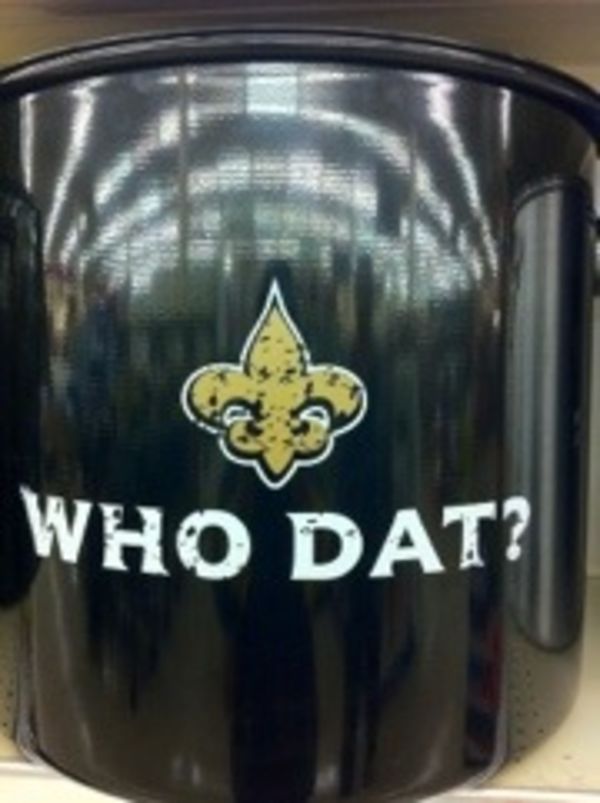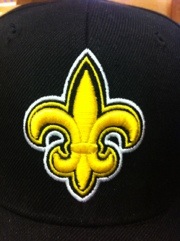Connecting in New Orleans: Saints, Daiquiris & Mardi Gras
February 18, 2012
Charlotte Makoff | KF 16 | New Orleans
A Terrible Event
On January 14, the most horrible thing happened. The Saints lost to the 49ers. I have never cared about any football team, not even my high school and college teams. And really, if I did care about a team in this game it should have been the 49ers — after all I am from San Francisco — but, this time, I cared about the Saints.
It wasn’t for myself, it was for everyone else in this city — the ones who have 12-foot-high inflatable football players in their front yards, the ones who wouldn’t dare step out their front door without first putting on black and gold, the ones wearing football jerseys and black circles smeared below their eyes with SAINTS painted in white. The crowds at sidewalk cafes who suddenly start chanting:
“Who Dat? Who Dat? Who Dat team gonna beat them Saints?” – Saints Ice Bucket
In New Orleans, the home team is part of the neighborhood, the family even. And it isn’t just sports fans who feel this way – it’s everybody. That’s why I wanted the Saints to win — so that everyone would keep cheering.
I knew that if the Saints lost, a pall would fall over the city, and fall it did. Cigars were smashed out half-smoked. At restaurants people stared balefully at the menus, ignoring the crawfish cheesecake and the alligator sausage po-boys — even their taste buds in mourning — and ordered black coffee. Street musicians in the French Quarter stared glumly at matchbook covers, wondering if a career in tele-sales was right for them. It was just too sad.
Things they have in New Orleans that you don’t see elsewhere
Drive-Thru Daiquiris
On a happier note, I’d like to talk about Drive-thru Daiquiri stands. An outsider might ask, “Where are the drive-thru gimlet stands? And how about the drive-thru martini stands – certainly there must be a few drive-thru mint julep stands?” But the residents here know that that’s just plain crazy. Who would want a drive-thru gimlet? Daiquiris are the only drink worthy of drive-thru status, and you can get any size, from 16 ounces on up to a full gallon ($24).
And the choice of flavors is just amazing – there must have been a hundred at the stand I drove through, everything from ‘Blue Quaalude’ to ‘Nuclear Waste’ to ‘190 Orange Anti-Freeze.’ I had a ‘Bitch Slap.’ By the way, you’re not allowed to drink them in your car – that’s why the Styrofoam cup comes with the lid taped down.
I see drive thru daiquiri stands as a symbol of the forgiveness native to New Orleans. People down here know that everyone messes up on occasion (sins if you will) and deserves to be forgiven. And if you do drive to the Daiquiri Hut, there’s a good chance you’re going to start that cycle. Human frailties are forgiven in this town.
If you went through a messy divorce in a small town in Nebraska, it’s likely the shadow of the event would follow you for the rest of your life. In New Orleans, people would just smile and shake their heads. Newt Gingrich belongs in this town. “Who cares what you did before, Newt?” everyone here would say, ”You’re willing to knock a few back, climb up on the bar and shout crazy ideas at the top of your lungs – you’re all right with us!”
Mardi Gras season
One night in mid-January we were wandering through the French Quarter, and we ended up on Bourbon Street. We were prepared for the usual assault on the senses. But that night, along with jolting layers of music coming from the bars, the jostling, happy crowds and the dozens of street performers, there was a strange sort of traffic jam. Huge party rooms on wheels were being pulled down the street by tractors. Inside the rooms, and dancing all around them, were men in robes and turbans, wearing wild masks and strings of beads the size of oranges. This was my first experience of a Krewe.
In most parts of the world where they celebrate Mardi Gras, the event lasts for one day. But in New Orleans, it spans an entire season. Starting on the Twelfth Night (12 nights after Christmas), which came on January 6th this year, it continues on through February 21st, Mardi Gras day. That’s a month and a half if you’re counting.
Krewes are social groups that parade through various parts of Louisiana during Mardi Gras season. This year, the first Krewe to parade in New Orleans was the Phunny Phorty Phellows, a ribald group of men who (along with their brass band the Storyville Stompers) ride the St. Charles Streetcar along its full route, sipping champagne and throwing beads to folks on the street.
There are scores of krewes in New Orleans, marching throughout Mardi Gras season. Some of the most interesting are the Mardi Gras Indians. The Mardi Gras Indians are African Americans, mostly men, but in recent years women have joined in their pageants. A while back I spoke with Shaka Zulu, the chief of the Yellow Pocahontas Tribe of Mardi Gras Indians, and a Kiva borrower. He explained to me how each of the members of the tribe spend a full year working on immense, intricately beaded and feathered costumes that cover their entire bodies (many weighing upwards of 100 pounds).
One of several Mardi Gras costumes on display at the Golden Feather restaurant.
Another Mardi Gras Indian Costume from a different year
Shaka Zulu told me that back before the civil war, when slaves tried to escape from their owners, the local Indian tribes often hid them and took care of them. The tradition of making and marching in the costumes is one way the Mardi Gras Indians pay homage to the Indians that saved their ancestors.
Some of Shaka Zulu’s costumes are on display in his restaurant, The Golden Feather, at 704 North Rampart Street in New Orleans. They are an absolute feast for the eyes, in color, shape and texture. Across the street is Louis Armstrong Park, which was originally the site of Congo Square, a place that slaves used to gather on their one day off, Sunday.
In those times people sold wares in an open air market, and there was much playing of music and dancing. The food Shaka Zulu serves at his restaurant is the food one would have found for sale at Congo Square in slave times. Shaka Zulu also plans to have a shop at the Golden Feather that will carry all the necessary materials for creating the Mardi Gras Indian Costumes.
So cheer the Saints, drink daiquiris, enjoy the Mardi Gras Indians and fund Kiva loans — especially those in New Orleans. This city has spirit, and the Kiva entrepreneurs here are no exception. Both working and playing hard, they ride the floats, march in the bands, and walk with the Krewes. When I came here as a Kiva Fellow, I thought I’d stay and experience my first Mardi Gras. I never dreamed that I’d know the queen of the 2012 Krewe de Vieux, Deon Haywood; a member of Mondo Kayo marching club, Michelle Levine; or Shaka Zulu, the King of Yellow Pocahontas. Kiva has opened so many doors.
Charlotte is a Kiva Fellow working with ASI Federal Credit Union in New Orleans.
You can also follow Kiva New Orleans on Facebook or join the Kiva New Orleans lending team.
PREVIOUS ARTICLE
Week in Review: Let’s Talk About Shorty Awards and Eye Opening Experiences →NEXT ARTICLE
Social Performance In Action: Tech Training and Education in Costa Rica →



















